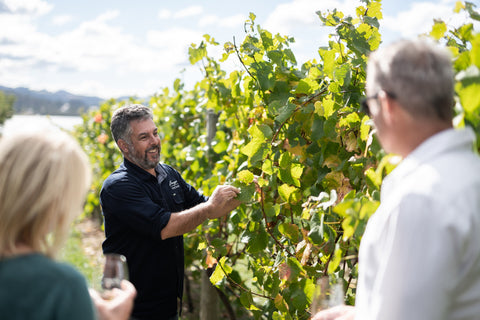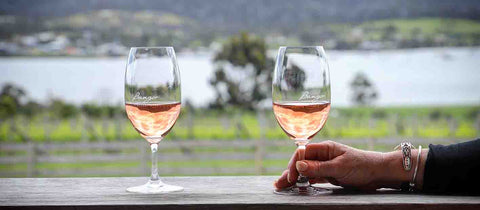DANGEROUS GIRLS | HARDSHIP | DETERMINATION | WINE | FOOD
Saturday 25th Nov, 3-6pm
On Saturday 25 November, Bangor Vineyard Shed brought a unique Tasmanian story to life at the Cascades Female Factory in Hobart - a place where the echoes of convict women’s lives still linger in the sandstone walls.
Through storytelling, heritage, and a glass of Bangor wine, guests joined us for an unforgettable evening exploring the story of Ann Eccles, an 18-year-old convict woman from Liverpool whose journey to Van Diemen’s Land became part of the Dunbabin family history.
A Journey into Tasmania’s Convict Past
The Cascades Female Factory, now a UNESCO World Heritage site, was one of Australia’s most significant convict institutions for women. Between 1828 and 1856, more than 5,000 women and children passed through its gates. Many endured hardship and separation; others built resilience, community, and hope.
At our special event, Notorious Strumpets & Dangerous Girls, guests experienced a private guided tour through the site, uncovering the harsh realities and enduring strength of the women who lived there. The stories shared reminded us that Tasmania’s past is woven with courage, struggle, and transformation - themes that continue to shape the island’s identity today.
Ann Eccles: A Convict Woman’s Story
Our family's journey, like many on the island, begins with the convergence of two paths: those of John Dunbabin and Ann Eccles, convicts whose narratives have become entwined with our own.
While the tales of male convicts at Port Arthur are often recounted, the experiences of convict women resonate within the walls of the Female Factory. It was here, in 1837, that Ann's story unfolded on Tasmanian soil at just 18, a world away from her life in Liverpool.
Ann’s legacy endures not only through the family she helped build, but through the spirit of determination that still defines Bangor today. Her story is a powerful reminder of the resilience of women who endured transportation, isolation, and reinvention in a harsh new world.
“The stories of Tasmania’s convict women remind us that courage and resilience can transform even the hardest beginnings.”
— The Dunbabin Family
The Event: History, Storytelling, and Connection
Hosted within the atmospheric walls of the Cascades Female Factory, our afternoon combined history, conversation, and connection.
Guests were treated to:
An exclusive private tour of the re-developed Female Factory site, led by the knowledgeable guides behind Notorious Strumpets & Dangerous Girls, bringing convict women’s stories vividly to life. This was a very touching connection with Tasmanian convict history - with the stories of the babies that died within the walls of the Female Factory bringing tears to our eyes.
-
A heartfelt talk by Tom Dunbabin, who shared the Dunbabin families' personal connection to Ann Eccles, her history and journey, and the ongoing effort to preserve Bangor’s rich heritage.
-
A captivating presentation by Dr Christina Henri, creator of The Bonnet Project, a moving art installation honouring each of the 25,566 convict women transported to Australia. Dr Henri presented us with a bonnet to honour Ann Eccles and her journey as a convict, and later a free citizen of Van Diemen's Land.
-
A relaxed Bangor wine and nibbles reception, allowing guests to reflect, connect, and toast to Tasmania’s extraordinary women.

Tasmania’s Female Convict Heritage
Tasmania’s convict women helped shape the island’s communities, families, and culture. Their stories are not just about hardship, but about endurance, motherhood, and hope.
Today, the Cascades Female Factory Historic Site stands as a place of remembrance and education, preserving these stories for generations to come. By bringing Bangor’s family history to this remarkable place, we honour those women and ensure their legacies continue to be told.
Learn more about the Cascades Female Factory
Read more about the Bonnet Project
Bangor’s Living Heritage
At Bangor, our connection to the past runs deep. The 6,000-hectare Bangor property on the Tasman Peninsula has been cared for by the Dunbabin family since 1890. From its early farming days to the thriving Bangor Vineyard Shed, Bangor’s story is one of stewardship, sustainability, and respect — for both people and place.
Bangor is home to millennia of Aboriginal history, along with European history dating back to Abel Tasman's landing on our shores in 1642, and convict farming history in the 1800's. Bangor is also home to a large number of animals and birds, including some of Tasmania's most precious and iconic species. Marsupial residents include Tasmanian devils, wallabies, bettongs, wombats and quolls. There are over 120 bird species including wedge-tailed eagles, sea eagles and swift parrots. The protection and sustainability of this special environment forms the core of everything we do here at Bangor.
Read more about Bangor's history
Read more about Bangor's environment
Tom Dunbabin - Family Historian

We were thrilled to have Tom Dunbabin share his knowledge with us about his ancestor Ann Eccles and her journey from Liverpool to Van Diemen's Land. Tom has written a fascinating account of Ann's life after extensive research. Limited copies were printed, but if you are interested in a copy of the book please email us: info@bangorshed.com.au
A Liverpool Lass
Ann Eccles in Van Diemen's Land
By Tom Dunbabin
Excerpt from Tom Dunbabin's book - A Liverpool Lass
"Ann Eccles was born two hundred years ago, in 1818. She was my great-great-grandmother and lived half her life in Liverpool, Great Britain, and half in Van Diemen’s Land, as Tasmania was known prior to 1856. When a young woman she was convicted of a relatively minor stealing offence, forcibly removed from her home and transported for seven years. It was a fate shared by thousands of women in the first half of the 19th century and the documentation of their stories has enhanced our understanding of the challenges they faced. In researching this biography, I have acquired a much greater appreciation of Ann’s experience and an admiration of what she achieved in her short lifetime. She died in 1852, aged 33."
Eccles Sparkling Rosé
Bangor Vineyard is very excited to announce a brand new wine - our very first Sparkling Rosé, made from pinot noir grapes from our vineyard. This Rosé is named Eccles in honour of Ann's courage and enduring legacy. This special new wine will be released late 2025. Join our email newsletter to keep an eye out for its release, and join the Bangor Wine Club to be the first to taste this exciting new wine.
Did You Know?
Why is the Cascades Female Factory so significant?
Located in South Hobart, the Cascades Female Factory was a major convict site for women transported to Tasmania in the 1800s. More than 5,000 women and children lived and worked there between 1828 and 1856, making it one of the most important places in Australia’s convict history. Today, it’s recognised as a UNESCO World Heritage Site, sharing the stories of those women with visitors from around the world.
How is Bangor connected to Tasmania’s convict history?
Bangor’s story is deeply linked to Tasmania’s early European settlement. Our ancestor Ann Eccles was one of the women transported to Van Diemen’s Land and later began a new life at Bangor with her husband, John Dunbabin (a convict transported from the Bangor region of Wales). Their journey from the Cascades Female Factory to the Tasman Peninsula is part of the living history we celebrate today.
Can visitors explore Bangor’s history in person?
Absolutely. We love sharing the stories behind our land, wines, and heritage. Visit us at Bangor Vineyard Shed for wine tastings, lunch overlooking Boomer Bay, and a warm Tasmanian welcome. You can also discover our latest heritage and music events on our What’s On page



